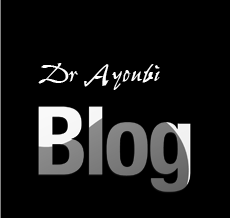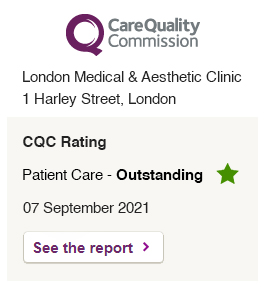
If you’re considering CO2 laser resurfacing, you’re probably excited about the results but also curious about recovery. One of the most common questions patients ask is: Will I peel after a CO2 laser?
The short answer is yes. Peeling is a completely normal and expected part of the healing process. It’s actually a good sign that your skin is renewing itself. But how much peeling will you have, how long does it last, and how should you care for your skin during this stage?
In this guide, I’ll explain everything you need to know about peeling after CO2 laser resurfacing, so you’ll know exactly what to expect and how to make your recovery as smooth as possible.
Why Does Peeling Happen After CO2 Laser?
When you undergo CO2 laser resurfacing, the procedure works by creating controlled, precise damage to the outer layers of your skin. The laser essentially vaporizes the damaged or aged skin cells, which then encourages your body to produce fresh, healthy new ones underneath.
Because of this process, you’ll notice the top layers of your treated skin starting to peel away in the days following the procedure. This peeling might seem a little surprising at first, but it’s completely normal. It’s your body’s natural way of shedding old, damaged cells to reveal the clearer, smoother, and rejuvenated skin that’s been forming underneath.
You can think of it as a kind of deep exfoliation but much more advanced and precise than anything you could achieve with scrubs or over-the-counter products. While it might feel a bit uncomfortable or look dramatic at first, it’s a key part of how your skin heals and renews itself after the treatment.
When Will Peeling Start?
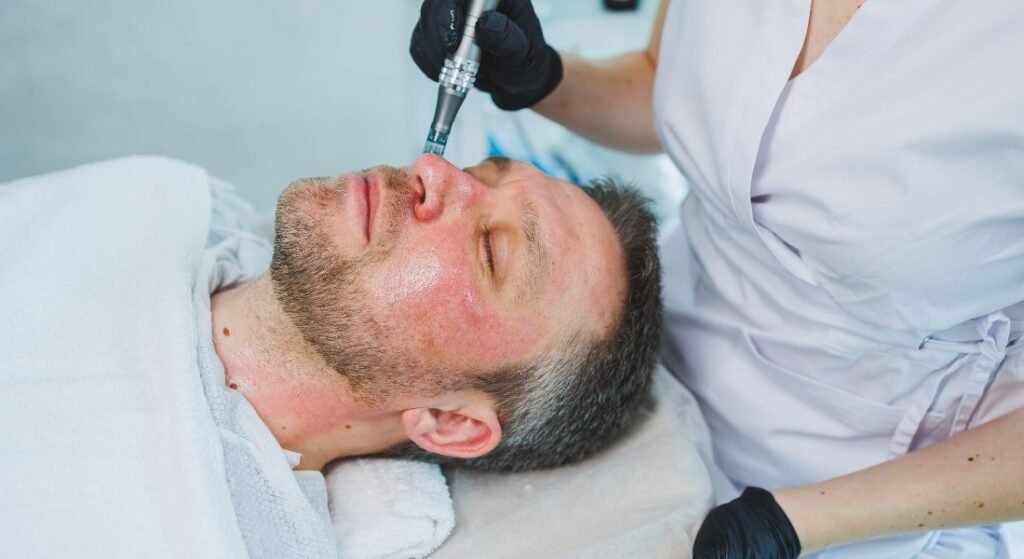
For most people, you’ll typically begin to notice peeling within a few days after your CO2 laser treatment. At first, your skin may feel tight, a bit sensitive, and look quite red almost like a sunburn. This is completely normal and actually a good sign that your skin is responding to the treatment and starting its healing process.
A few days later, you’ll start seeing dry flakes and peeling patches appear. This is the part where the transformation really begins to show. You’re literally shedding the old, damaged layers of skin, making way for fresh, smoother, and healthier skin underneath. While it may look a little dramatic at first, it’s all part of your skin renewing itself and moving toward the refreshed, rejuvenated results you’re aiming for.
It’s also worth noting that peeling may not be perfectly uniform. Some areas may shed faster than others, and that’s completely normal. Your skin heals in stages, and variations in peeling are simply part of your body’s natural repair process. Over time, all areas will catch up, and the final results will be even, smooth, and glowing.
How Long Does Peeling Last?
After your CO2 laser treatment, you can expect the peeling phase usually lasts about a week, though it can vary depending on your skin and treatment depth. First, the depth of your treatment plays a big role. If your procedure was more superficial, targeting only the top layers of your skin, you might notice peeling for just a few days. On the other hand, deeper resurfacing treatments can cause peeling to continue for up to two weeks.
Your individual skin type also affects how long peeling lasts. Some people naturally shed skin more quickly, while others may experience a slower, more gradual process. Another important factor is how carefully you follow the aftercare instructions provided by your dermatologist or practitioner. Keeping your skin hydrated, avoiding harsh products, and protecting it from the sun can all help your skin heal more smoothly and may even make peeling feel more manageable.
Remember, while peeling can feel a little uncomfortable or look a bit dramatic, it’s a normal and essential part of the healing process. It’s your skin’s way of getting rid of old, damaged cells so that the fresh, rejuvenated skin underneath can shine through.
What Does the Peeling Look Like?
After your CO2 laser treatment, peeling usually happens in stages, and it’s helpful to know what to expect so you’re not caught off guard:
Day 1–2: Right after your treatment, your skin will likely feel red, swollen, and tight almost like a sunburn. This is completely normal and part of your skin’s healing response.
Day 3–5: Within a few days, you’ll start noticing dryness and small patches of peeling or flaking. This is your skin beginning to shed the damaged outer layers.
Day 5–10: Over the next several days, peeling may become more noticeable, sometimes in larger sheets or flakes. Don’t be alarmed if it looks dramatic this is just your skin renewing itself.
Day 10+: By this point, most of the peeling has subsided, revealing smoother, fresher skin underneath. You may notice a soft pink tone as your new skin continues to strengthen.
It’s also completely normal if your peeling doesn’t look perfectly even. Different areas of your face or treated skin may heal at slightly different rates, and that’s nothing to worry about. Your skin is simply taking the time it needs to recover and regenerate.
What You Should Not Do During Peeling
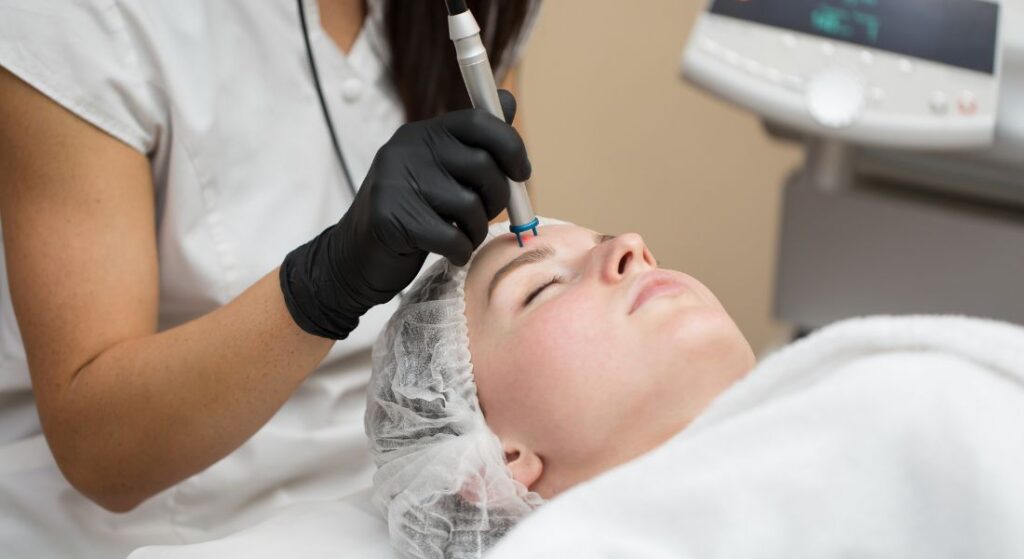
When your skin starts peeling after a CO2 laser treatment, it can be tempting to pick at those flakes or scrub away the dead skin but it’s very important that you resist. Interfering with your skin’s natural healing can slow recovery and even lead to scarring. Here’s a quick list of what you should avoid:
– Don’t peel or pick at flakes. Let your skin shed naturally to prevent scarring or irritation.
– Don’t scrub your skin. Harsh rubbing can damage the fresh skin underneath.
– Don’t use strong cleansers or exfoliants. Stick to gentle products recommended by your specialist.
– Don’t expose your skin to direct sunlight. Newly resurfaced skin is especially sensitive to UV damage.
– Don’t apply heavy makeup until your provider gives you the go-ahead.
Letting your skin peel at its own pace is the safest way to ensure a smooth, healthy recovery.
How to Care for Peeling Skin
Taking proper care of your skin during peeling can make the process more comfortable and help you heal faster. Here’s how you can support your skin:
Moisturize regularly: Apply the ointments or creams recommended by your specialist. Keeping your skin hydrated reduces tightness, itching, and speeds up healing.
Cleanse gently: Use mild, non-foaming cleansers. Instead of rubbing, pat your skin dry.
Apply cool compresses: This can soothe itching and ease the tight feeling that often comes with peeling.
Protect from the sun: Wear SPF 30 or higher daily and avoid prolonged direct sunlight to prevent damage.
Stay hydrated: Drinking plenty of water supports your skin’s natural healing from the inside out.
By following these steps, you’re giving your skin the best chance to regenerate smoothly and reveal its fresh, healthy layers.
How Does Peeling Affect Results?
Peeling is actually a key part of what makes CO2 laser treatments so effective. As your skin sheds the damaged outer layers, your body naturally reveals healthier, smoother, and younger-looking skin underneath.
Once the peeling phase is over, you may notice:
– A clearer, brighter complexion.
– Reduced age spots and pigmentation.
– Fewer fine lines and wrinkles.
– Smoother, more even skin texture.
So, even though peeling can look a little alarming at first, it’s actually a positive sign that your skin is renewing itself and working toward the final results you’re hoping for.
Will Everyone Peel the Same Way?
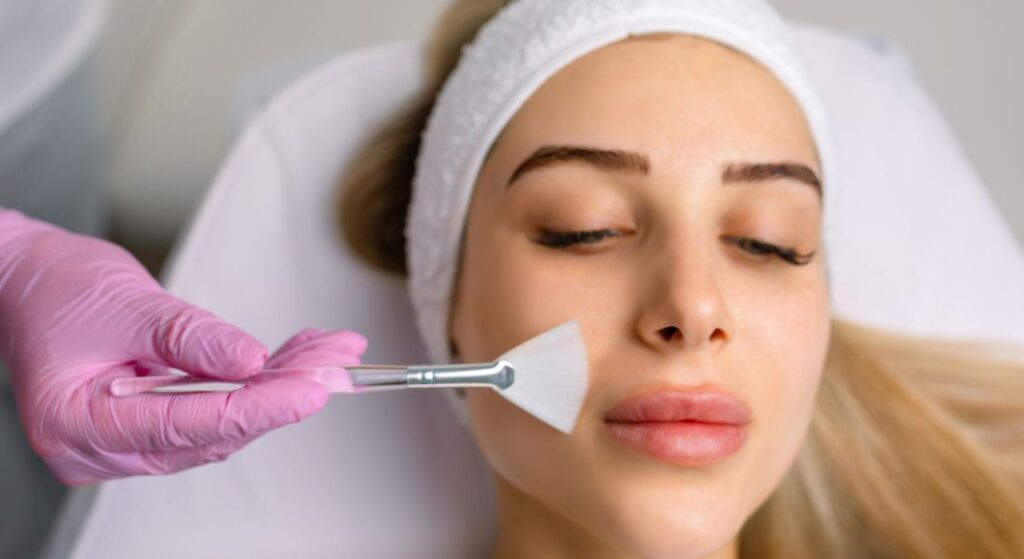
Not everyone will peel in exactly the same way, and that’s completely normal. How much peeling you experience depends on several factors:
Depth of treatment: Deeper CO2 laser treatments usually lead to more noticeable peeling.
Your skin type: Some people naturally peel more than others, even with the same treatment.
Aftercare: How well you moisturize, protect your skin from the sun, and follow your dermatologist’s instructions can influence how peeling progresses.
Age: Younger skin often heals faster and may peel for a shorter period.
The most important thing to remember is not to compare your experience with anyone else’s. Your skin is unique, and your healing process is too.
Can Peeling Be Reduced or Prevented?
It’s important to know that you can’t completely prevent peeling after a CO2 laser treatment that’s simply a natural part of how your skin heals and renews itself. Peeling is your body’s way of shedding damaged cells and making room for fresh, healthy skin underneath.
That said, you can take steps to make the process more comfortable and manageable. For example:
Keep your skin well-moisturized: Regularly applying the ointments or creams recommended by your provider helps reduce dryness and tightness.
Use cool compresses: They can soothe itching or discomfort that sometimes comes with peeling.
Avoid things that dry out your skin: Hot showers, saunas, and harsh cleansers can make peeling worse or more uncomfortable, so it’s best to steer clear of them.
Think of peeling as a temporary step a short phase that may feel a little inconvenient, but it’s a small price to pay for the long-term benefits. Once the peeling is over, you’ll be left with healthier, smoother, and rejuvenated skin that makes the wait completely worth it.
How Does Peeling Differ From Other Treatments?
If you’ve tried treatments like chemical peels or microdermabrasion before, you might notice a big difference with CO2 laser resurfacing. While those methods only remove the very surface layers of your skin, the CO2 laser goes deeper. It penetrates multiple layers to stimulate a more profound renewal process.
Because of this deeper impact, the peeling you experience after a CO2 laser treatment is more significant and noticeable. That also means your downtime may be longer compared to lighter treatments. But the trade-off is worth it your results are much more dramatic. You’ll likely see smoother skin texture, improved tone, fewer fine lines, and an overall fresher, younger-looking appearance.
In short, peeling with CO2 laser isn’t just surface-level exfoliation it’s your skin’s way of undergoing a deep reset for longer-lasting and more visible improvements.
What If My Skin Doesn’t Peel?
It’s natural to worry if you don’t notice obvious peeling after your CO2 laser treatment. Some people expect dramatic flakes and sheets of skin to come off, but in lighter or more superficial treatments, the exfoliation may be very subtle. You might barely see peeling, and that’s completely normal.
Even if you don’t notice visible flakes, your skin is still actively renewing itself beneath the surface. The laser stimulates your skin to produce fresh, healthy cells, so the benefits are happening whether or not you see obvious peeling.
If you’re feeling concerned or unsure about your progress, don’t hesitate to reach out to your provider. During follow-up appointments, they can examine your skin, ensure your healing is on track, and give you personalized advice on how to care for your skin moving forward. Remember, visible peeling isn’t the only sign that your skin is recovering it’s happening at a deeper level, quietly and effectively.
The Emotional Side of Peeling
It’s completely normal to feel a bit self-conscious while your skin is peeling. Redness, flaking, and tightness can make you more aware of your appearance, especially in visible areas like your face or hands. Most people around you won’t even notice, but if you’d like extra comfort, gentle makeup like mineral powders or tinted moisturizers can help once your provider says it’s safe. You can also plan a few days of downtime or low-key outings to feel more at ease. Remember, peeling is just a temporary phase on the way to smoother, healthier, and more radiant skin, and the results are well worth the wait.
FAQs:
1. Will everyone peel after a CO2 laser treatment?
Not everyone experiences peeling in the same way after a CO2 laser. Factors like the depth of your treatment, your individual skin type, age, and adherence to aftercare instructions all play a role. Some people notice dramatic peeling in large sheets, while others may only experience subtle flaking. Even if peeling seems minimal, your skin is still renewing itself beneath the surface, and the results are still occurring.
2. How soon does peeling start after the procedure?
Peeling usually begins around three to five days following CO2 laser resurfacing. Initially, the skin may feel tight, appear red, and be slightly swollen, similar to a sunburn. This early phase signals the start of your skin’s natural healing process, and over the next few days, dry flakes and peeling patches will gradually emerge as the old skin sheds to reveal fresh, new layers underneath.
3. How long does the peeling phase last?
The duration of peeling can vary depending on the treatment depth and your skin type. Typically, it lasts from five to ten days, but deeper treatments may extend peeling up to two weeks. Some people notice peeling lasts a bit longer than others, and that’s totally normal—your skin is just taking its own pace to reveal fresh, healthy layers underneath. Following your provider’s aftercare instructions can help ensure the process is as smooth and comfortable as possible.
4. Is the peeling process painful?
Peeling usually isn’t painful, though your skin might feel a little tight or itchy—this is just part of your skin’s natural renewal. Some discomfort is normal, especially in the first few days when redness and swelling are present. Applying recommended moisturizers and soothing compresses can help alleviate tightness and itching, making the recovery experience more manageable.
5. Can peeling be prevented or reduced?
It is not possible to completely prevent peeling after a CO2 laser because it is a natural part of the skin’s healing and renewal process. However, the experience can be made more comfortable by keeping the skin well-moisturized, avoiding harsh cleansers, and staying out of direct sunlight. Using gentle, soothing products and following aftercare instructions can reduce discomfort and help the peeling appear less dramatic.
6. How should I care for my skin while it’s peeling?
Proper skincare during the peeling phase is crucial for optimal results. Gentle cleansing, regular application of recommended ointments or moisturizers, and protection from UV exposure are essential. Avoid picking or scrubbing the peeling skin, as this can cause irritation or scarring. Drinking plenty of water and using cool compresses when needed can also support the healing process.
7. Will peeling affect the final results of my CO2 laser treatment?
Peeling is a positive indicator that the treatment is working. As the damaged outer layers shed, healthier, smoother skin emerges beneath. This phase contributes to the improvement of skin tone, texture, and overall appearance. Once the peeling subsides, patients typically notice a clearer complexion, reduced pigmentation, and diminished fine lines, demonstrating that peeling is an essential step in achieving optimal results.
8. What if my skin doesn’t peel visibly?
Some people may not notice significant peeling, especially after lighter treatments. Even without visible flakes, your skin is still undergoing the renewal process below the surface. The laser stimulates new cell growth and collagen production, meaning the rejuvenation benefits are happening whether or not peeling is dramatic. Follow-up appointments with your provider can ensure your healing is on track.
9. Can I wear makeup while my skin is peeling?
It is generally advised to avoid makeup until your provider confirms it is safe to use. It’s best to hold off on makeup for a little while—this helps your skin heal smoothly and keeps your new layers looking even and healthy. If covering your skin is necessary for short periods, it’s best to use minimal, gentle products that are non-comedogenic and avoid areas that are actively flaking.
10. How can I manage the emotional impact of peeling?
The peeling phase can make some patients feel self-conscious due to redness, flaking, and tightness. Planning downtime, postponing social events, or simply understanding that the process is temporary can help manage these feelings. Remember, peeling is a short-term stage with long-term benefits. Focusing on the rejuvenated results that are emerging beneath the surface can make this phase easier to navigate and less stressful.
Final Thoughts: Peeling After CO2 Laser
Peeling and recovery after CO2 laser resurfacing are key steps in revealing healthier, smoother skin. While the process can feel a bit dramatic, it’s a sign that your skin is actively renewing itself. By following proper care including gentle cleansing, regular moisturization, and sun protection you can support a safe and effective healing process.
If you’re considering CO2 laser treatment at London Medical & Aesthetic Clinic, Dr Ayham Al-Ayoubi will guide you through every stage with precision and expertise. His approach ensures long-lasting, natural-looking results while making your recovery as smooth and comfortable as possible.
References:
1. Yumeen, S. (2023). Laser Carbon Dioxide Resurfacing. In: StatPearls [Internet]. Treasure Island (FL): StatPearls Publishing. Available at: https://www.ncbi.nlm.nih.gov/books/NBK560544/
2. Ramsdell, W. (2012). Fractional CO2 Laser Resurfacing Complications. In: StatPearls [Internet]. Treasure Island (FL): StatPearls Publishing. Available at: https://pmc.ncbi.nlm.nih.gov/articles/PMC3580977/
3. Preissig, J. (2012). Current Laser Resurfacing Technologies: A Review that Compares the Efficacy and Safety of Different Laser Systems. In: StatPearls [Internet]. Treasure Island (FL): StatPearls Publishing. Available at: https://pmc.ncbi.nlm.nih.gov/articles/PMC3580982/
4. Manuskiatti, W. (1999). Long-term effectiveness and side effects of carbon dioxide laser resurfacing. In: Journal of the American Academy of Dermatology, 41(6), 1024-1030. Available at: https://www.sciencedirect.com/science/article/abs/pii/S0190962299704895
5. Ward, P.D. (2008). Long-term Results of Carbon Dioxide Laser Resurfacing of Facial Rhytides. In: Archives of Facial Plastic Surgery, 10(4), 238-243. Available at: https://www.liebertpub.com/doi/10.1001/archfaci.10.4.238

